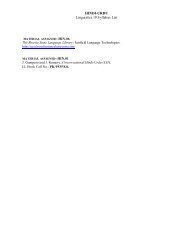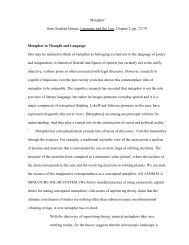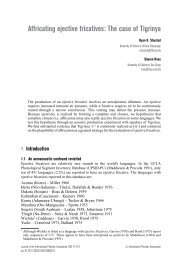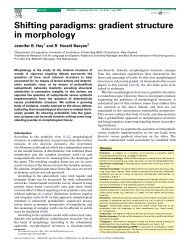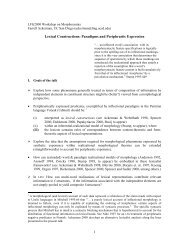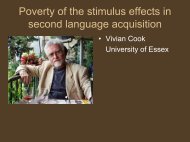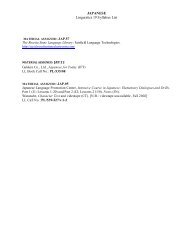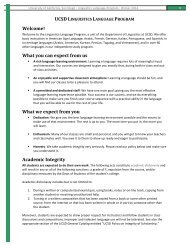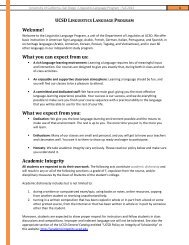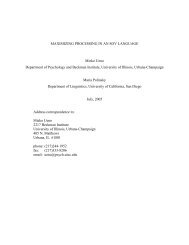The morphological structure of the Moro verb Sharon Rose
The morphological structure of the Moro verb Sharon Rose
The morphological structure of the Moro verb Sharon Rose
Create successful ePaper yourself
Turn your PDF publications into a flip-book with our unique Google optimized e-Paper software.
<strong>The</strong> <strong>morphological</strong> <strong>structure</strong> <strong>of</strong> <strong>the</strong> <strong>Moro</strong> <strong>verb</strong><br />
initial roots with initial H tone, in which <strong>the</strong> clause marker is deleted due to<br />
hiatus, or with 1 st and 2 nd person dependent clause constructions in which<br />
class marker and clause marker are absent, downstep is observed: é- ↓ g-áfː-a<br />
‘s/he is about to shoot/build’. <strong>The</strong>refore, <strong>the</strong> downstep already observed<br />
between some clause markers and default tone also occurs between H-toned<br />
subject markers and default tone. Note that <strong>the</strong> default tone does not appear<br />
in 1PL.EXC and 3PL forms <strong>of</strong> <strong>the</strong> dependent clause. <strong>The</strong> lack <strong>of</strong> default H tone<br />
in <strong>the</strong>se forms is also observed in <strong>the</strong> subordinate constructions discussed<br />
below.<br />
In subordinate forms, <strong>the</strong> subject marking paradigm is different, both in <strong>the</strong><br />
segmental and tonal form <strong>of</strong> <strong>the</strong> markers, but also <strong>the</strong> tone patterns <strong>of</strong> <strong>the</strong><br />
paradigm. First, <strong>the</strong> subject markers that are segmentally identical to <strong>the</strong><br />
subject markers in <strong>the</strong> o<strong>the</strong>r patterns in (34) do not have H tone. Second, <strong>the</strong><br />
3 rd person subject markers are invariable and do not indicate noun class. <strong>The</strong><br />
3SG subordinate form is áŋ(ə́)- and <strong>the</strong> consecutive is ə́ŋ(ə́)-. Third, <strong>the</strong> tone<br />
on <strong>the</strong> <strong>verb</strong> stem is default tone in all persons except <strong>the</strong> 1PL.EXCL and 3PL<br />
forms, which lack default H tone.<br />
(35)<br />
PERSON/NUMBER SM SUBORDINATE CONSECUTIVE<br />
1SG e- e-ʧómbəð-a e-ʧómbəð-a<br />
2SG a- a-ʧómbəð-a a-ʧómbəð-a<br />
3SG áŋ(ə́)-/ə́ŋ(ə́)- áŋ(ə́)- ↓ ʧómbəð-a ə́ŋ(ə́)- ↓ ʧómbəð-a<br />
1DU.INC al(ə)- al(ə)-ʧómbəð-a al(ə)-ʧómbəð-a<br />
1PL.INC al(ə)- -r al(ə)-ʧómbəð-a-r al(ə)-ʧómbəð-a-r<br />
1PL.EXC ɲa- ɲa-ʧombəð-a ɲa-ʧombəð-a<br />
2PL ɲa- ɲa-ʧómbəð-a ɲa-ʧómbəð-a<br />
3PL alə-/lə- alə-ʧombəð-a alə-ʧombəð-a<br />
<strong>The</strong> complementizers that accompany <strong>the</strong> subordinate or consecutive can<br />
add a H tone onto <strong>the</strong> subject markers.<br />
5.4 Complementizers<br />
<strong>The</strong>re are three complementizers that attach at <strong>the</strong> left edge <strong>of</strong> <strong>the</strong> <strong>verb</strong><br />
stem: nə́-, nə- and t ̪ə́-. <strong>The</strong> complementizer nə́- occurs on subordinate forms<br />
and on non-subject relative clauses, clefts and wh-questions, while <strong>the</strong> o<strong>the</strong>r<br />
two are restricted to <strong>the</strong> consecutive, nə- occurring on <strong>the</strong> perfective and t ̪ə́-<br />
on <strong>the</strong> imperfective:<br />
19




